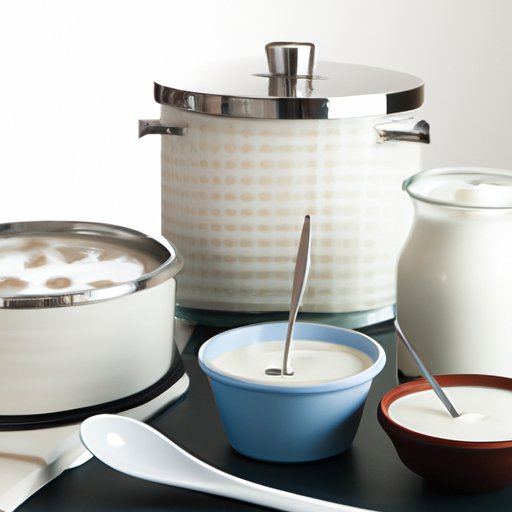Introduction
Yogurt starter is a combination of bacteria and yeast that causes milk to thicken and curdle, transforming it into yogurt. Making your own yogurt starter at home can be a great way to save money, control the ingredients in your yogurt, and ensure that you always have a supply of fresh, homemade yogurt on hand.

Supplies and Equipment Needed to Make a Yogurt Starter
To make a yogurt starter, you’ll need the following supplies and equipment:
- Milk
- Yogurt culture or yogurt starter powder
- Thermometer
- Pot
- Measuring cups
- Containers
- Optional: Cheesecloth

Steps Involved in Making a Yogurt Starter
Making yogurt starter is a simple process that involves just a few steps:
- Heat the milk: Heat the milk to 185°F (85°C). This will kill any harmful bacteria and denature the proteins in the milk, making it easier for the yogurt culture to thrive.
- Cool the milk: Once the milk has reached 185°F (85°C), remove it from the heat and allow it to cool to 110°F (43°C). This is the optimal temperature for the yogurt culture to grow.
- Add the yogurt culture or starter powder: Add 1 teaspoon of yogurt culture or starter powder per quart of milk. Stir the mixture until it is evenly distributed. If using a yogurt starter powder, you may want to strain the mixture through a cheesecloth to remove any clumps.
- Incubate the mixture: Transfer the mixture to an airtight container and place it in an incubator or warm spot (ideally between 98°F and 110°F [37°C and 43°C]). Allow the mixture to incubate for 8 to 12 hours, or until it thickens and develops a tart flavor.

Benefits of Making Your Own Yogurt Starter
Making your own yogurt starter has several benefits, including:
- Freshness: Homemade yogurt starter is fresher than store-bought, since it hasn’t been sitting on a shelf for months or even years.
- Cost savings: Making your own yogurt starter is much less expensive than buying it from the store.
- Control over ingredients: When you make your own yogurt starter, you can control the type of milk and yogurt culture used, as well as the amount of sugar added. This allows you to customize the flavor and texture of your yogurt.
Tips for Storing and Maintaining the Yogurt Starter
Once you’ve made your yogurt starter, it’s important to store and maintain it properly in order to keep it fresh and viable. Here are some tips for storing and maintaining your yogurt starter:
- Refrigeration: To keep your yogurt starter fresh, store it in an airtight container in the refrigerator. It should stay fresh for up to two weeks.
- Freezing: You can also freeze your yogurt starter. Place it in an airtight container and freeze for up to three months. Thaw it in the refrigerator overnight before using.
- Reusing the starter: You can reuse your yogurt starter up to five times, as long as it smells and tastes normal. After five uses, discard the starter and start over with a new batch.
Recipes That Use Yogurt Starter
Once you have your yogurt starter, you can use it to make a variety of delicious yogurt recipes. Here are a few recipes that use yogurt starter:
- Greek-Style Yogurt: Greek-style yogurt is thicker and creamier than traditional yogurt. To make it, add 2 tablespoons of yogurt starter to 1 quart of milk and incubate for 8 to 10 hours.
- Vanilla Yogurt: Vanilla yogurt is a sweet and creamy treat. To make it, add 2 tablespoons of yogurt starter to 1 quart of milk and add 1/4 cup of sugar. Incubate for 8 to 10 hours.
- Fruit-Flavored Yogurt: For fruit-flavored yogurt, add 2 tablespoons of yogurt starter to 1 quart of milk and stir in 1/2 cup of mashed fruit. Incubate for 8 to 10 hours.
Conclusion
Making your own yogurt starter is a great way to save money, control the ingredients in your yogurt, and enjoy the freshest possible yogurt. With the right supplies and equipment, it’s easy to make a yogurt starter at home.
(Note: Is this article not meeting your expectations? Do you have knowledge or insights to share? Unlock new opportunities and expand your reach by joining our authors team. Click Registration to join us and share your expertise with our readers.)
